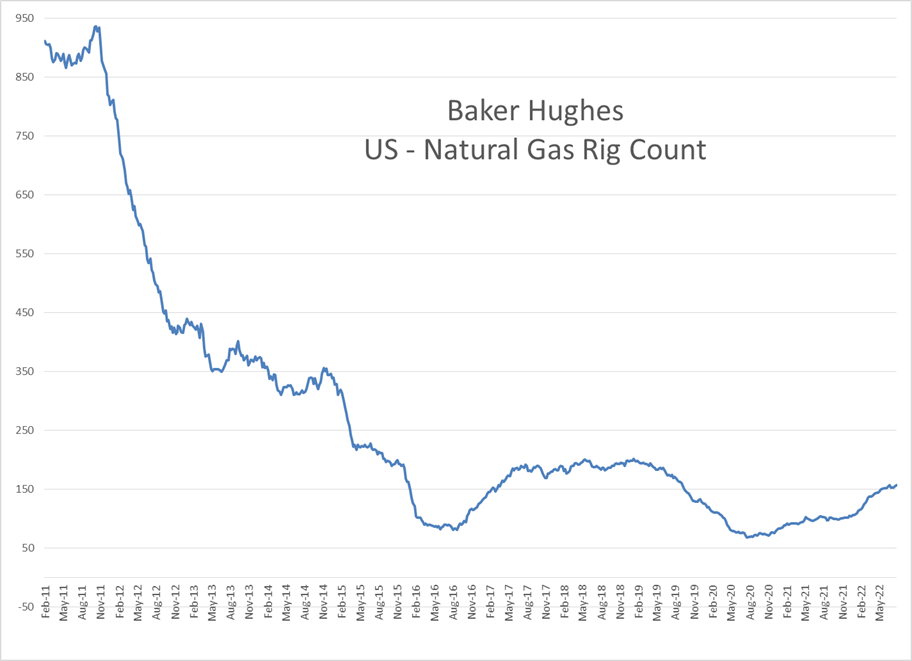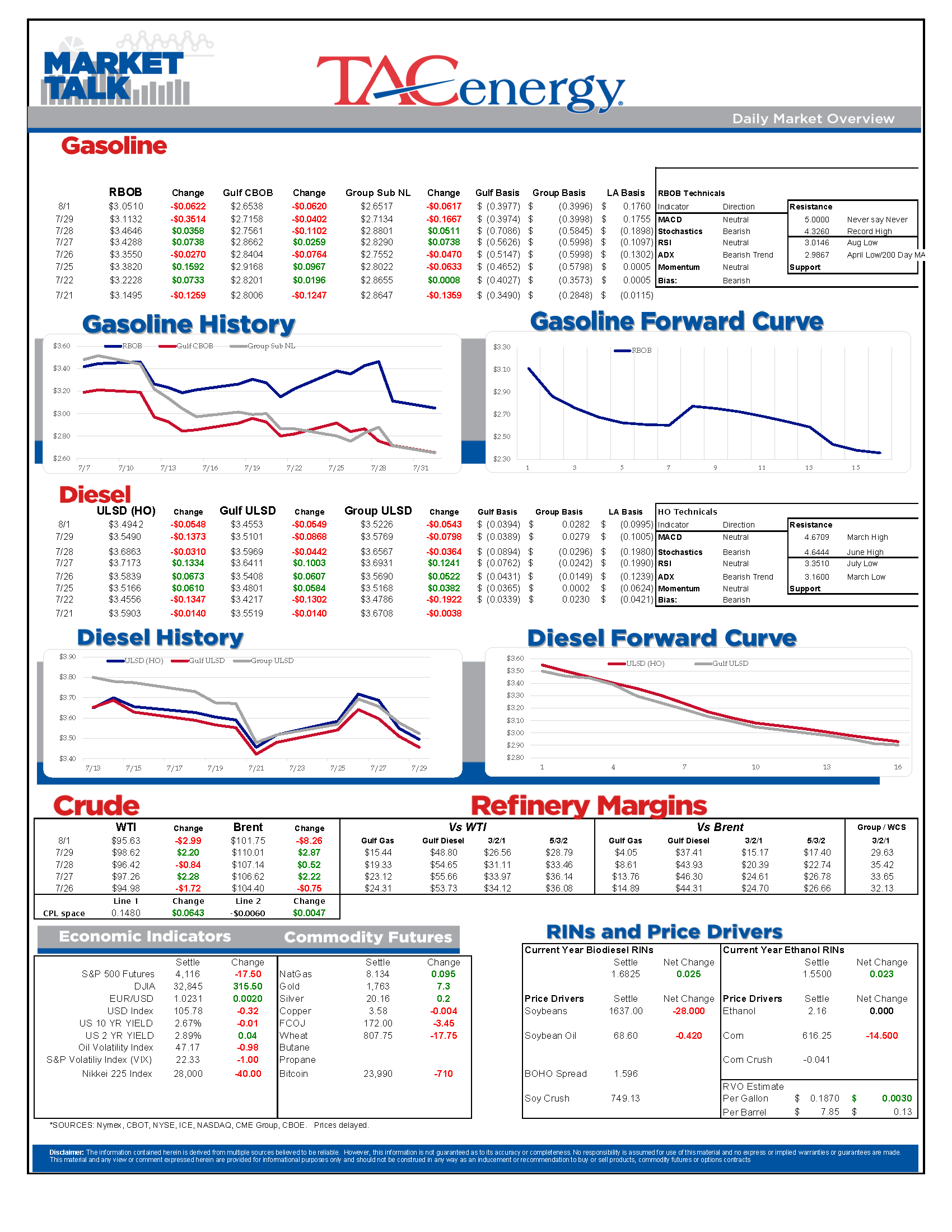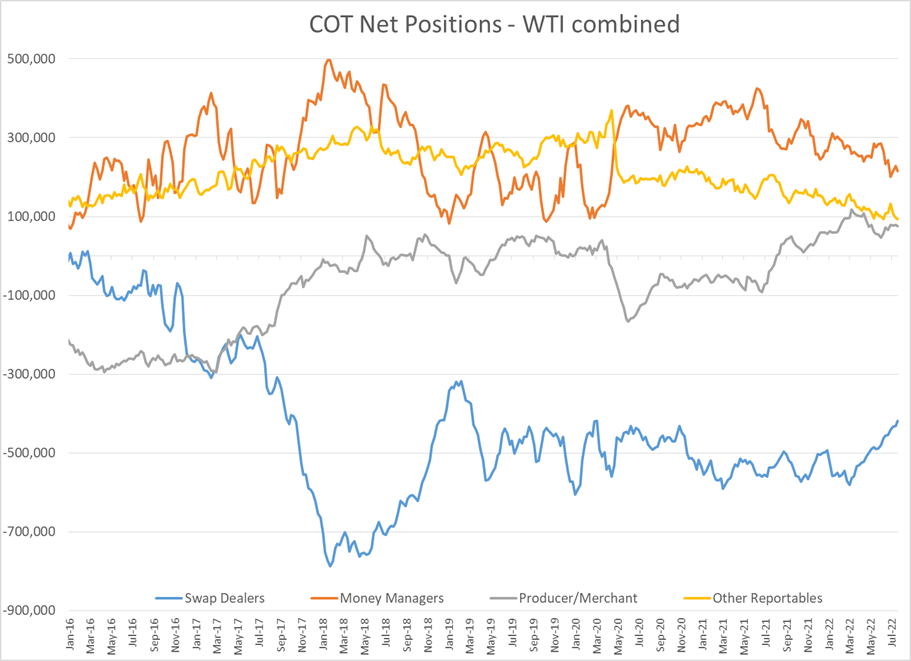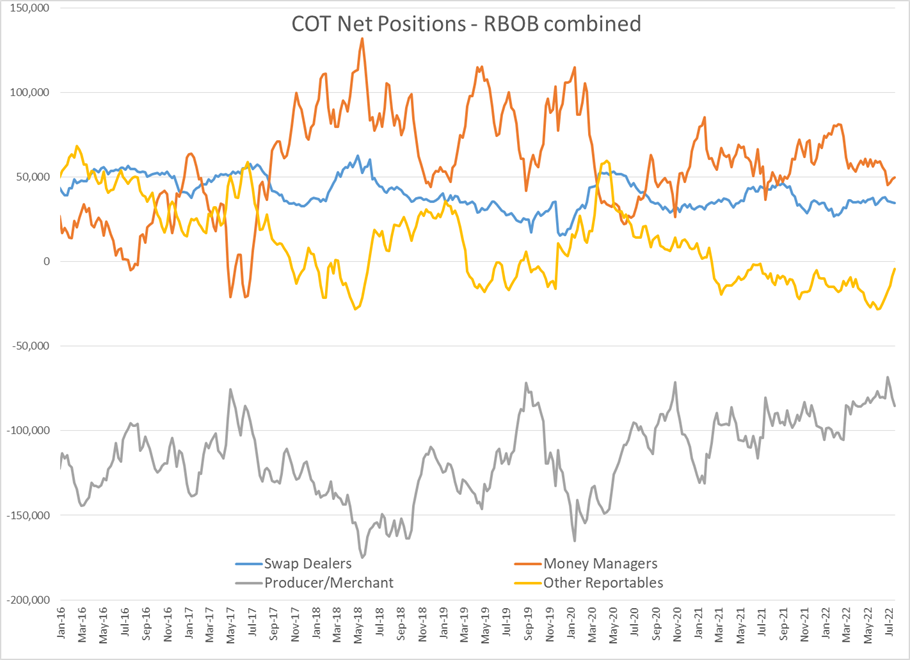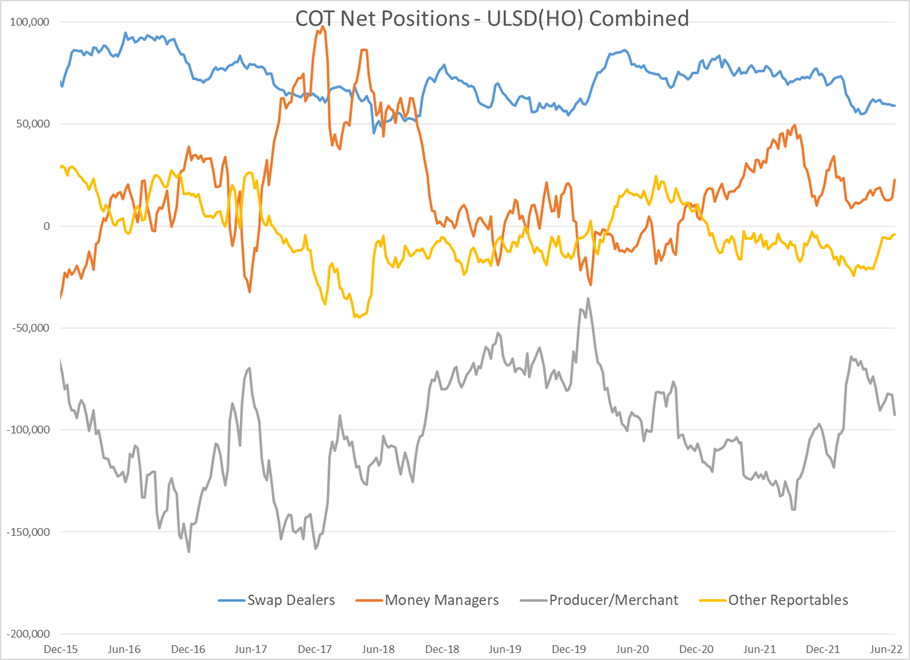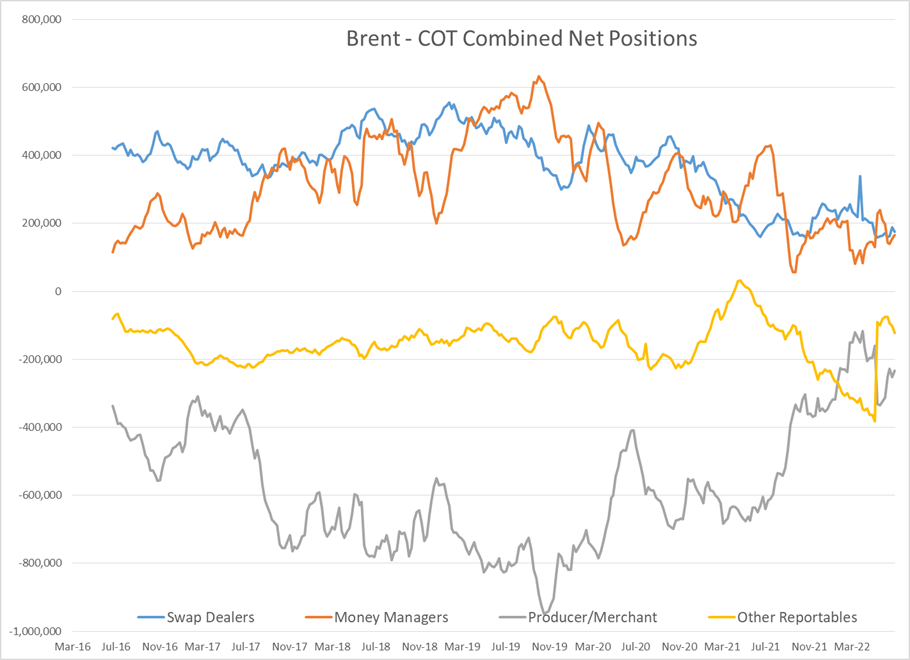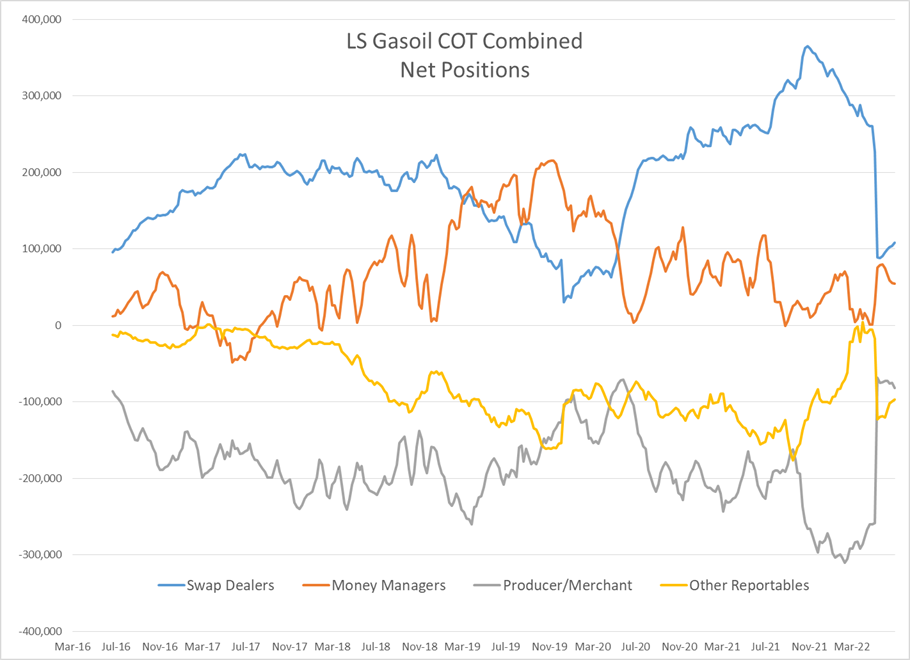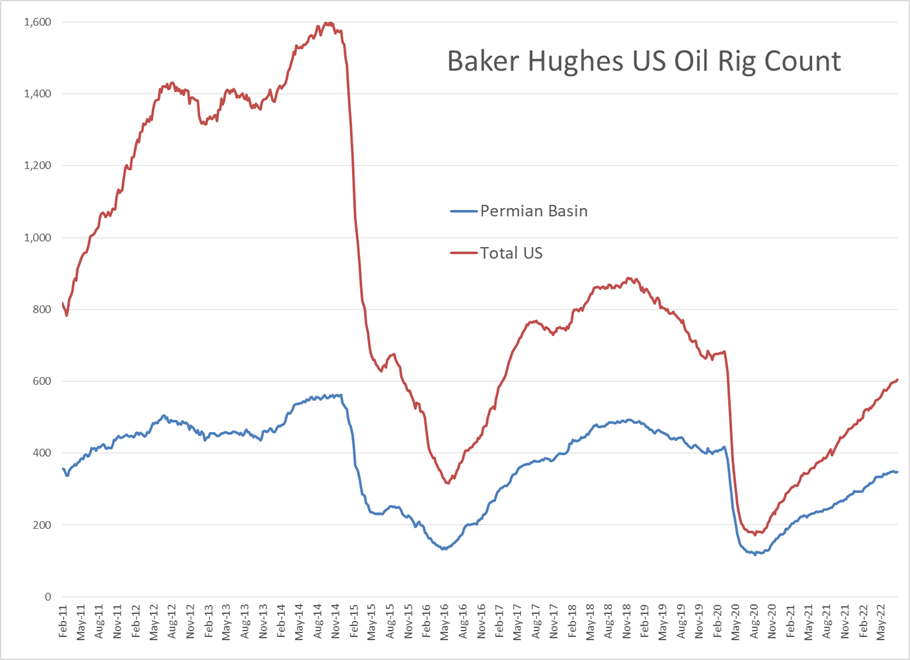It’s Been A Busy And Choppy Start To Trading In August As The Energy Complex Tests The Lower End Of Its Summer Trading Range

It’s been a busy and choppy start to trading in August as the energy complex tests the lower end of its summer trading range, creating some big swings in the early going. RBOB gasoline was down almost a dime around 7am central, but has cut those gains in half in 30 minutes. ULSD prices were down 8 cents at 7, rallied to down 3 as of 7:30, then were down almost 7 again by 7:45.
RBOB faces an immediate technical test to start the month, with the contract roll bringing prices from a high of $3.71 on Friday, to a test of $3 today. The $3 range has 3 layers of chart support, marking the July low of $3.02, the psychologically meaningful $3 mark, and the 200 day moving average at $2.99. IF these layers of support break, it looks like we’ll see another 15 cent drop in short order, with a move into the $2.70s possible. Speaking of which, the September RBOB contract is the last summer-spec contract of the year, and the October contract is already trading in the high $2.70s this morning thanks to the combination of steep backwardation and RVP transition. Cash markets are adding to the bearish feel for gasoline prices, with several regional values already around $2.65 this morning, which will mean retail prices below $3.50 coming soon for many consumers if the trend holds.
WTI is also facing another test at its 200 day moving average, after bouncing off of that level in 6 of the past 8 trading sessions. If US oil prices don’t find a way to rally soon (as in this week) it looks like we’ll be talking about oil in the $80s some-time in August.
While gasoline and oil prices look weak on the charts, ULSD is looking relatively strong, with a more neutral outlook. The roll from the expiring August contract did move prompt prices into the lower half of the summer trading range, but there’s still more than 12 cents to fall before chart support gets tested for diesel.
The CFTC’s commitment of traders report shows that money managers continue to have mixed feelings on energy price bets, with the only consistency seen in recent weeks being a lack of open interest outstanding. The open interest for refined products is holding at its lowest levels since 2015, which was when the US fracking boom helped petroleum prices go bust. Here too ULSD looks the most bullish with new speculative longs entering the market last week, while other funds covered short positions, leading to large increase in net length held by money managers on the week.
Baker Hughes reported a net increase of 6 oil rigs and 2 natural gas rigs last week, ending a 2 week lull in new drilling activity. Texas led the increase with 6 new rigs added last week, 2 each in the Permian and Eagle Ford plays. The total US oil rig count surpassed 600 for the first time since April of 2020 (you might remember this as the month when WTI traded negative) and leaves the possibility that the rig count could reach pre-pandemic levels by year end.
It’s been almost a month since we saw a named storm in the Atlantic, and the NHC suggests this will be another quiet week. Despite the calm waters, forecasters are still calling for an above average hurricane season, and it’s not just the Gulf Coast refining complex that seems extra vulnerable this year: A WSJ article highlights how a shortage of transformers could spell trouble for turning the lights back on after a storm hits.
Click here to download a PDF of today's TACenergy Market Talk.
Latest Posts
Energy Markets Rally Again Thursday After A Choppy Wednesday Session
Week 16 - US DOE Inventory Recap
Energy Markets Trading Quietly In The Red As Ethanol Prices Rally To Five-Month High
The Struggle For Renewable Producers Continues As A Rapid Influx Of Supply And Crashing Credit Prices Make Biodiesel
Social Media
News & Views
View All
Energy Markets Rally Again Thursday After A Choppy Wednesday Session
Energy markets are trying to rally again Thursday after a choppy Wednesday session. RBOB gasoline futures are leading the push higher, on pace for a 3rd consecutive day of gains after finding a temporary floor Tuesday and have added 12 cents from those lows.
Equity markets are pointing sharply lower after a weak Q1 GDP estimate which seems to have contributed to a pullback in product prices over the past few minutes, but don’t be surprised if the “bad news is good news” low interest rate junkies start jumping in later on.
The DOE’s weekly report showed sluggish demand for gasoline and diesel, but inventory levels in most markets continue to follow their typical seasonal trends. Refinery runs held fairly steady last week with crude inputs down slightly but total gross throughputs up slightly as most facilities are now back online from a busy spring maintenance season and geared up for peak demand this summer.
Propane and propylene exports spiked to a record high north of 2.3 million barrels/day last week, which demonstrates both the US’s growing influence on global product markets, and the steady shift towards “other” products besides traditional gasoline and diesel in the level of importance for refiners.
The EIA acknowledged this morning that its weak diesel consumption estimates reflected the switch to Renewable Diesel on the West Coast, although they did not provide any timeline for when that data will be included in the weekly survey. The agency acknowledged that more than 4% of the total US consumption is now a combination of RD and Biodiesel, and that number is expected to continue to grow this year. This morning’s note also suggested that weak manufacturing activity was to blame for the sluggish diesel demand across the US, while other reports suggest the freight recession continued through Q1 of this year, which is also contributing to the big shift from tight diesel markets to oversupplied in several regions.
Valero kicked off the Q1 earnings releases for refiners with solid net income of $1.2 billion that’s a far cry from the spectacular earnings north of $3 billion in the first quarter of 2023. The refining sector made $1.7 billion, down from $4.1 billion last year. That is a pattern that should be expected from other refiners as well as the industry returns to a more normal market after 2 unbelievable years. You wouldn’t guess it by looking at stock prices for refiners though, as they continue to trade near record highs despite the more modest earnings.
Another pattern we’re likely to see continue with other refiners is that Renewable earnings were down, despite a big increase in production as lower subsidies like RINs and LCFS credit values sting producers that rely on those to compete with traditional products. Valero’s SAF conversion project at its Diamond Green joint venture is progressing ahead of schedule and will give the company optionality to flip between RD and SAF depending on how the economics of those two products shakes out this year. Valero also shows part of why refiners continue to disappear in California, with operating expenses for its West Coast segment nearly 2X that of the other regions it operates in.

Week 16 - US DOE Inventory Recap

Energy Markets Trading Quietly In The Red As Ethanol Prices Rally To Five-Month High
Energy markets are trading quietly in the red to start Wednesday’s session after a healthy bounce Tuesday afternoon suggested the Israel-Iran-linked liquidation had finally run its course.
There are reports of more Ukrainian strikes on Russian energy assets overnight, but the sources are sketchy so far, and the market doesn’t seem to be reacting as if this is legitimate news.
Ethanol prices have rallied to a 5-month high this week as corn and other grain prices have rallied after the latest crop progress update highlighted risks to farmers this year, lower grain export expectations from Ukraine, and the approval of E15 blends this summer despite the fact it pollutes more. The rally in grain and renewables prices has also helped RIN values find a bid after it looked like they were about to test their 4-year lows last week.
The API reported small changes in refined product inventories last week, with gasoline stocks down about 600,000, while distillates were up 724,000. Crude oil inventories increased by 3.2 million barrels according to the industry-group estimates. The DOE’s weekly report is due out at its normal time this morning.
Total reported another upset at its Port Arthur refinery that’s been a frequent flier on the TCEQ alerts since the January deep freeze knocked it offline and damaged multiple operating units. This latest upset seems minor as the un-named unit impacted was returned to normal operations in under an hour. Gulf Coast basis markets have shrugged off most reports of refinery upsets this year as the region remains well supplied, and it’s unlikely we’ll see any impact from this news.
California conversely reacted in a big way to reports of an upset at Chevron’s El Segundo refinery outside of LA, with CARBOB basis values jumping by more than a dime. Energy News Today continued to show its value by reporting the upset before the flaring notice was even reported to area regulators, proving once again it’s ahead of the curve on refinery-related events. Another industry news outlet meanwhile struggled just to remember where the country’s largest diesel seller is located.
Click here to download a PDF of today's TACenergy Market Talk
